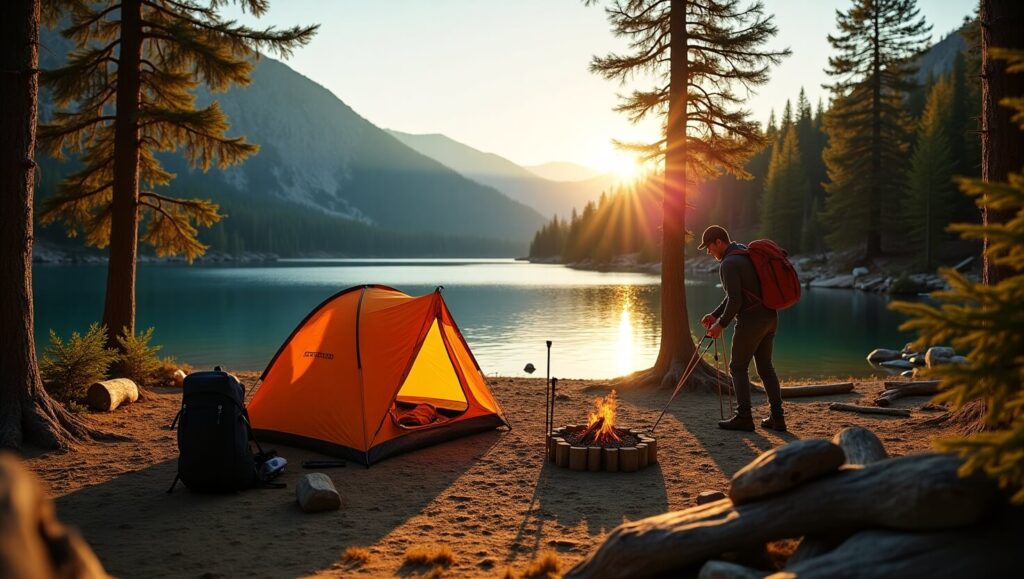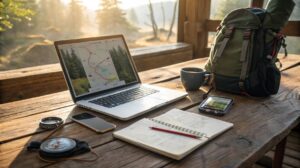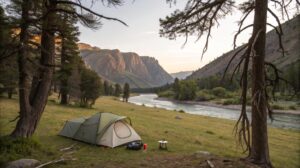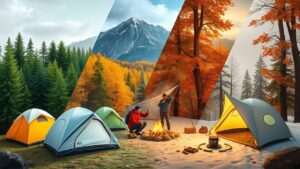Introduction:
Let me paint you a picture: My first camping trip was a masterclass in what not to do. I chose a spot that looked like it belonged on a postcard—a serene lakeside nook framed by towering pines. But by midnight, my tent was submerged in a puddle, raccoons had ransacked my snacks, and the rhythmic thud of hikers on a nearby trail kept me awake until dawn.
That trip taught me a valuable lesson: knowing how to choose the best campsites isn’t just about aesthetics. It’s about safety, comfort, and respecting nature’s whims. Over the years, through trial and error (and a few more raccoon encounters), I’ve honed a step-by-step system to find the perfect patch of wilderness. Whether you’re a weekend warrior, a backpacking purist, or a glamper with a taste for luxury, this guide will help you pitch your tent—or park your RV—like a pro. Let’s dive in.
Step 1: Research Like a Pro (Your Trip Starts at Home)
Think of campsite research like online dating: you need to vet your options before committing.
1.1 Campground Directories and Reviews: The Good, the Bad, and the Bug-Infested
Websites like TripAdvisor and niche platforms like The Trek are goldmines for honest reviews. Look for keywords like “noisy,” “pristine,” or “mosquito haven.” For example, during a trip to Yellowstone, I skipped a highly rated site near Old Faithful after reading complaints about midnight bison traffic jams. Instead, I snagged a quieter spot in the Pebble Creek area, where I fell asleep to the sound of a bubbling stream—not grumpy tourists.
Pro Tip: Filter reviews by season. A site that’s “peaceful” in fall might be a crowded nightmare in summer.
1.2 Google Earth: Your Secret Weapon
Satellite imagery isn’t just for spies. Use Google Earth to:
- Spot flat terrain (tilt the view to check for slopes).
- Identify water sources (great for hydration, bad for mosquitoes).
- Avoid flood zones (look for dried-up riverbeds or erosion patterns).
On a recent trip to Utah’s Canyonlands, Google Earth saved me from pitching my tent in a washout zone that flash floods had carved into a mini-Grand Canyon.
1.3 Talk to the Experts: Rangers and Locals
When planning a trip to Acadia National Park, I called the ranger station and asked, “Where would YOU camp if you wanted peace and quiet?” The ranger directed me to a hidden site near Duck Brook, far from the crowds. Local knowledge is priceless—use it.
Pro Apps for Research:
- The Dyrt: Filter sites by amenities (think: “pet-friendly” or “stargazing hotspots”).
- AllTrails: Check trail difficulty and recent camper photos.
Step 2: The 5 Non-Negotiables for Any Campsite
2.1 Terrain and Ground Conditions
- Flat and Elevated: A 1–3° slope drains rainwater without rolling you into your tentmate. Avoid depressions—they become ponds.
- Firm Soil: Test the ground with your foot. Loose sand? Your stakes will fail. Rocky terrain? Hello, backache.
- Natural Cushioning: Pine needles or leaf litter > jagged rocks. On a Colorado trip, I slept like a baby on a bed of aspen leaves.
2.2 Water Proximity: The Goldilocks Rule
- Too Close: Mosquitoes, condensation, and midnight raccoon raids. The Leave No Trace Center recommends camping 200 feet from water to protect ecosystems.
- Too Far: Hauling water uphill is torture. In Arizona’s Superstition Mountains, I split the difference—close enough for refills, far enough to avoid swampy air.
2.3 Shelter from the Elements
- Windbreaks: Position your tent’s narrow end against the wind. In Wyoming’s Wind River Range, a cluster of boulders shielded me from 40 mph gusts.
- Sun Exposure: Morning sun dries dew; afternoon shade prevents a tent sauna. Avoid lone trees—they’re lightning magnets.
2.4 Safety First
- Widowmakers: Dead branches can crush your tent. Always look up!
- Wildlife: In bear country? Store food in a bear canister. I learned this the hard way in Montana’s Glacier National Park.
- Flash Floods: Dry riverbeds = danger. Camp above the high-water mark.
2.5 Privacy and Noise
- Natural Barriers: In California’s Big Sur, a thicket of manzanita bushes blocked noise from a nearby highway.
- Distance from Trails: Follow the White Mountain National Forest rule: Stay 200 feet from trails to avoid foot traffic.
Step 3: Match Your Campsite to Your Camping Style
Not all campers are the same. Use this table to find your match:
| Camper Type | Priorities | Ideal Features | Gear Recommendations |
|---|---|---|---|
| Family Campers | Safety, amenities, kid-friendly | Playgrounds, flush toilets, fire rings | Coleman Cabin Tent, portable high chair |
| Backpackers | Lightweight, solitude, trail access | Remote sites, water sources, minimal crowds | Hyperlite Ultamid Tent, water filter |
| Glampers | Comfort, luxury, Instagram appeal | Safari tents, hot showers, Wi-Fi | Bell Tent with Stove Jack, solar-powered string lights |
| Adventure Seekers | Proximity to climbing/hiking | Rugged terrain, off-grid locations | Black Diamond Climbing Kit, GPS device |
Sources: Family camping tips, Backpacker essentials, Glamping trends
Step 4: Leave No Trace (Because Nature Isn’t Your Trash Can)
- Camp on Durable Surfaces: Stick to established sites to protect fragile plants.
- Pack Out All Trash: Even apple cores. In Yosemite, I met a ranger who showed me photos of deer sick from eating food scraps.
- Fire Safety: Use existing fire rings. In 2020, 85% of wildfires were caused by humans. Don’t be that person.
Step 5: Advanced Tips for Seasoned Campers
5.1 Weather Mastery
- Microclimates: Coastal sites (think Oregon’s Cannon Beach) are foggy; valleys (like Death Valley) trap heat.
- Apps: Windy predicts wind patterns; Dark Sky gives hyperlocal rain alerts.
5.2 Seasonal Strategies
- Spring: Avoid muddy trails in the Smokies.
- Summer: Seek high-elevation sites (e.g., Colorado’s Maroon Bells) to escape heat.
- Fall: Michigan’s Upper Peninsula offers bug-free leaf-peeping.
- Winter: Use a hot tent stove for sub-zero camping.
5.3 Group Camping Hacks
- Layout: Place tents in a semicircle with a central fire pit.
- Noise Control: Assign a “quiet time” (10 PM works).
Step 6: Gear That Elevates Your Campsite Game
- Sleep Systems: The NEMO Disco Sleeping Bag balances warmth and weight.
- Navigation: Garmin’s inReach Mini sends SOS signals in no-service zones.
- Lighting: LuminAID Solar Lanterns charge via USB.
Step 7: Common Mistakes (And How to Avoid Them)
Ignoring Weather Reports: A friend learned this the hard way when a hailstorm shredded his tent in the Rockies.
Overpacking: A 65L backpack forced me to ditch non-essentials mid-hike.
Poor Food Storage: Hang food 10 feet up and 4 feet from tree trunks.
Conclusion:
Camping isn’t about perfection. That time I forgot tent stakes and used rocks instead? It’s now a campfire legend. Prepare thoroughly, but leave room for adventure.
The best campsites aren’t just places to sleep—they’re where you’ll swap stories under the stars, bond over burnt marshmallows, and realize that raccoons are nature’s master thieves.
Happy trails, and may your campsite be critter-free (or at least entertaining).
For more, explore Leave No Trace ethics or dive into camping gear deep-dives.
15 Best Off-Grid Camping Sites in America: Ultimate Guide for 2025
Additional Resources
If you’re interested in learning more about wilderness survival and mental techniques, here are some resources you might find helpful. They are usually my go-to’s:
- The Complete Off-Grid Camping Gear Guide for 2024: Talks comprehensively about off-grid camping gear.
- Lightweight Multi-Purpose Camping Tools: Talks about multi-purpose camping tools that’ll transform how you approach minimalist travel.
Frequently Asked Questions
1. How close should I camp to a water source?
While water access is essential, camping too close risks mosquito swarms, wildlife encounters, and environmental harm. Follow the Leave No Trace principle of staying 200 feet (60 meters) from lakes, rivers, and streams to protect ecosystems and avoid soggy ground.
2. What’s the biggest mistake first-time campers make?
Ignoring terrain! Many prioritize views over practicality. Avoid depressions (they flood) and rocky or sandy ground (unstable for tents). Always prioritize flat, elevated spots with natural cushioning like grass or pine needles.
3. How do I check for safety hazards at a campsite?
-
Look up: Scan for dead branches (“widowmakers”) that could fall in wind.
-
Look down: Avoid dry riverbeds (flash flood risks) and animal trails.
-
Look around: Steer clear of berry bushes or food scraps that attract wildlife.
4. What gear is essential for off-grid camping?
Beyond basics (tent, sleeping bag), pack:
-
Water filter (for remote sites).
-
Solar charger (e.g., Goal Zero).
-
Bear canister (in bear country).
-
Topographic map and compass (cell service is unreliable).
5. How do I balance privacy and convenience?
Use tools like The Dyrt to filter campsites by “seclusion” ratings. For backpackers, hike at least 1 mile from trailheads. For families, prioritize campgrounds with spaced-out sites and natural barriers like trees or rocks.





This is a fantastic post! Your take on the matter is unique and I value that. Keep up the amazing work!
Thanks! Your words mean a lot
This is the kind of content I always seek out online; truly informative and helpful.
Thank you!
Hello! I hope you’re having a great day. Good luck 🙂
Yes! Thank you